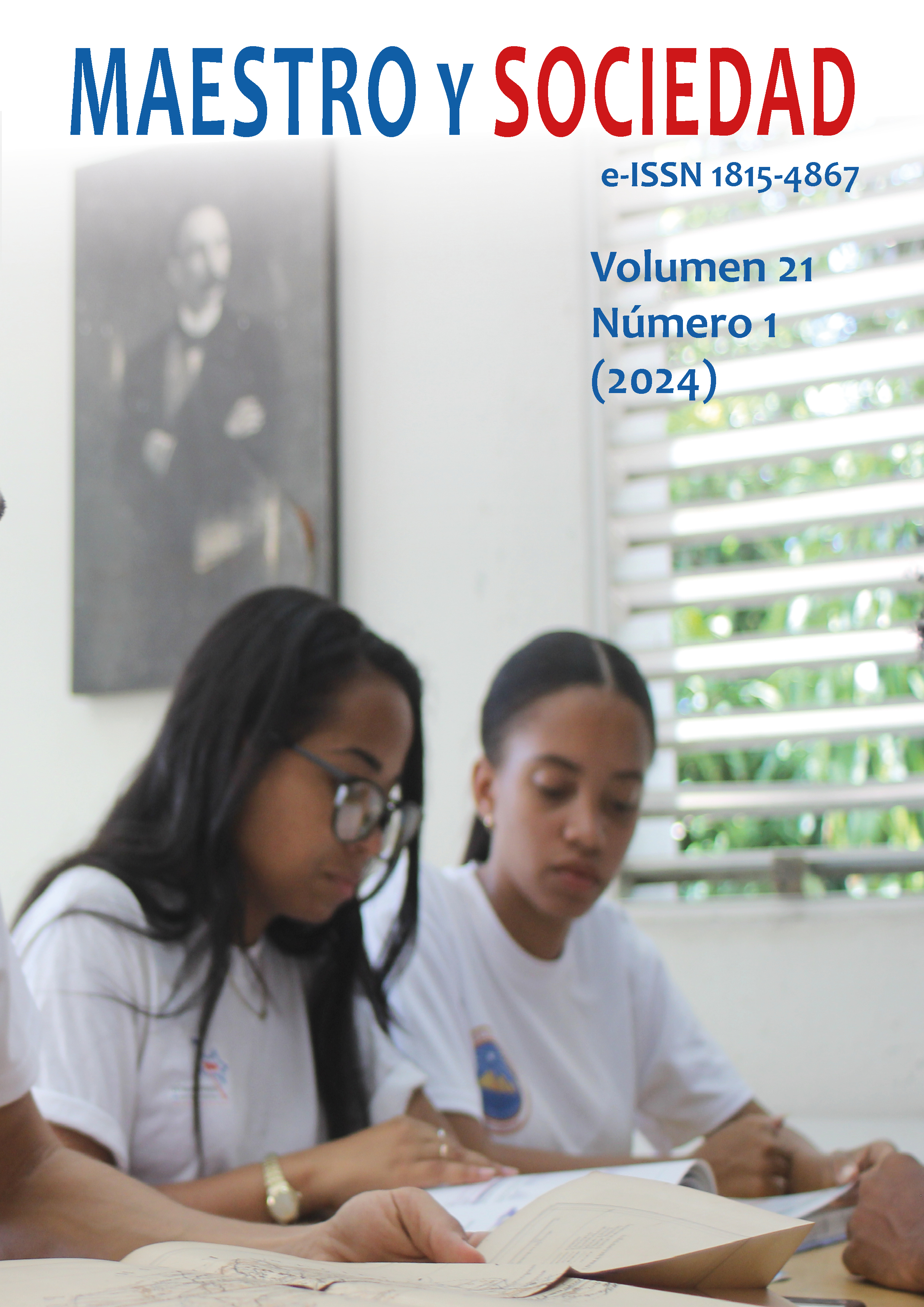Contribución al teatro para niños en Cuba de la maestra y pedagoga María Antonia Fariñas
Palavras-chave:
teatro, enseñanza, educación infantil, enseñanza artística, marionetaResumo
Introducción: En la presente investigación aborda, los insuficientes estudios investigativos relacionados con la vida y obra de la maestra María Antonia Fariñas, por el desconocimiento de su contribución pedagógica de la teatróloga y la escasa valoración de sus aportes. Materiales y métodos: Por lo que se realiza una minuciosa revisión bibliográfica que revelan su contribución artístico-pedagógica al Teatro para niños y de títeres en Cuba; elementos importantes a tener en cuenta en la formación inicial del educador no solo en la enseñanza artística. La epistemología y su recorrido abordan los referentes más directo del estudio y su contribución a la enseñanza artística en Cuba. Se desarrolló con un enfoque metodológico cualitativo, mediante un estudio exploratorio-descriptivo, utilizando el método historia de vida, el análisis documental, y la sistematización de experiencias de los autores. Resultados: Las contribuciones de esta investigación, están relacionadas con la Historia de la Pedagogía como ciencia, rectora de las Ciencias de la Educación, con un estudio acerca de la vida, obra educativa y legado artístico-pedagógico de María Antonia Fariñas, que se revela en el devenir histórico, mediante una periodización que enriquece el proceder metodológico para facilitar el análisis valorativo y la sistematización histórica, su contribución teórica, práctica y metodológica desde la pedagogía durante el periodo (1950-1999) al Teatro para niños en Cuba. Discusión: El teatro con títeres es un instrumento muy valioso para la educación en todos sus niveles, ya que sirve como pequeños auxiliares educativos en el aula, donde los niños obtienen un aprendizaje significativo. Conclusiones: Proporciona el acercamiento a una destacada protagonista e innovadora de las Artes Escénicas en Cuba, elemento importante a tener en cuenta para los que, de una forma u otra, están relacionados con este tipo de teatro, utilizado en la formación de educadores y en el proceso educativo de manera general.
Referências
Álvarez, L. y Ramos, J. R. (2003). Circunvalar el arte. La investigación cualitativa sobre la cultura y el arte. Editorial Oriente.
Barreiro, J. (2017). María Antonia Fariñas y su amor a las marionetas. En Cuba escena. La Habana.
Bamford, A. (2014). El impacto de las artes en la educación. https://starart6.webnode.es/l/bamford/
Buenavilla, R., Guzmán, A. y Pérez, S. D. (2009). Alternativas metodológicas para estudios históricos y de figuras representativas de la educación. Sello Editor Educación Cubana, Ministerio de Educación.
Cabrera, R. (2014). Indagaciones sobre arte y educación. Facultad de Artes Visuales. Universidad Autónoma de Nuevo León.
Cerezal, J y Fiallo, J. (2009). Cómo investigar en pedagogía. Editorial Pueblo y Educación.
Duarte, A. (2010). 60 Aniversario de la televisión cubana. Granma.
Espinosa, N. (2010). Dossier de Teatro de Títeres en Cuba. La Jiribilla de papel, (88).
Espinal, N. (2014). Fundamentación de la asignatura Teatro para la Educación Preescolar. Curso propio. Cuarto Año Curso Diurno Plan D. Carrera Licenciatura en Educación Preescolar Disciplina Práctica Integral de la Lengua Española Universidad de Oriente.
Garrido, Á. (1998). La Historia de vida como método de acercamiento a la realidad social. https://digibug.ugr.es/handle/10481/7548
Hervitz, S. (2018) ¿Qué es la Pedagogía Teatral? Revista de divulgación de experiencias pedagógicas MAMAKUNA (7), 56-61.
Isabelle, R. (2015). Los tipos. http://www.lostipos.com/de/teatro.html
Instituto Central de Ciencias Pedagógicas. (2016a). Adecuaciones para el perfeccionamiento del Sistema Nacional de Educación.
Instituto Central de Ciencias Pedagógicas. (2016b). Plan de estudios para la Educación primaria.
González, A. (2004). Jugar y Cultivar. Jardín y senderos que se bifurcan. Ediciones Plaza Vieja.
Motos, T. (2009). De Freire a Boal. Pedagogía del Oprimido-Teatro del Oprimido. https://dialnet.unirioja.es/servlet/articulo?codigo=7340772
Mulen, A. y Millet, M. (2017). Metodología para el estudio de personalidades en el proceso histórico-pedagógico. Universidad “Raúl Gómez García”.
Pujadas, J. (1992). El método biográfico: el uso de las historias de vida en ciencias sociales, CIS. Colección “Cuadernos Metodológicos”, (5).
Rodríguez, G., Gil, J. y García, E. (2006). Metodología de la investigación cualitativa. Editorial Félix Varela.
Publicado
Como Citar
Edição
Seção
Licença
Copyright (c) 2024 Roberto Hernández Zayas, Jesús Barreiro Yero, Karell Despaigne López

Este trabalho está licenciado sob uma licença Creative Commons Attribution-NonCommercial-NoDerivatives 4.0 International License.
Esta revista proporciona un acceso abierto inmediato a su contenido, basado en el principio de que ofrecer al público un acceso libre a las investigaciones ayuda a un mayor intercambio global de conocimiento. Cada autor es responsable del contenido de cada uno de sus artículos. Los artículos pueden ser inéditos o estar disponibles previamente en servidores de preprints reconocidos por la revista. Sin embargo, no se permite la duplicación de la publicación o traducción de un artículo ya publicado en otra revista o como capítulo de un libro.
This journal provides immediate open access to its content, based on the principle that providing the public with free access to research supports a greater global exchange of knowledge. Each author is responsible for the content of each of their articles. Articles may be previously unpublished or available on preprint servers recognized by the journal. However, duplication of publication or translation of an article already published in another journal or as a book chapter is not permitted.
Esta revista oferece acesso aberto imediato ao seu conteúdo, com base no princípio de que oferecer ao público acesso gratuito à pesquisa contribui para um maior intercâmbio global de conhecimento. Cada autor é responsável pelo conteúdo de cada um de seus artigos. Os artigos poderão ser inéditos ou estar previamente disponíveis em servidores de preprints reconhecidos pela revista. No entanto, não é permitida a duplicação de publicação ou tradução de artigo já publicado em outro periódico ou como capítulo de livro.



























 Universidad de Oriente
Universidad de Oriente 